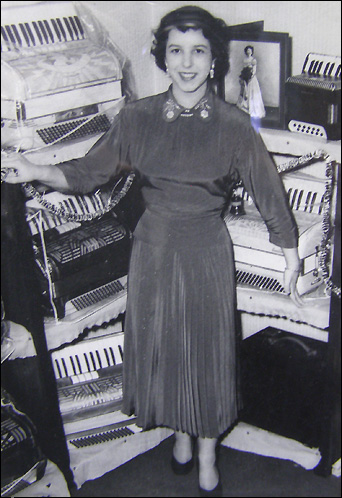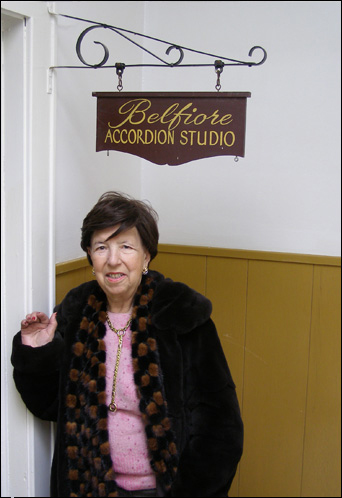 |
| |
|
|
| You have also written many methods for the accordion including those dealing with Bellow Shakes. How many books did your write in all, and are they still available today? | |||||||||
| I have written three Bellow
Shakes Books, and then there is the Mryon Floren method, which is five
books and the Technique Books. For solos, there is Valse Diane, (Eugene
Ettore later did an orchestration), the Pan Polka (Eugene later did an
arrangement of that one too) and Valse Cavalier. Most are available from
Ernest Deffner Music. I worked with Myron on the accordion method book,
we collaborated on those. In testing the books out, I used in with my
students, to see if what we were writing for the students was acceptable.
Works and Publications by Maddalena Belfiore:
|
|||||||||
|
|||||||||
| What was your fascination with the Bellow Shake? | |||||||||
| It wasn't something that was
a fascination to me, it was just something that came very easily to me.
I guess I took it for granted - just do it how I do it.. ok! There was
nothing really fascinating. I enjoyed doing the bellow shake enormously, and I know there is definate techinque in doing it. I was doing bellow shake before I started with Frosini. I worked on it with him, but I was already doing this before I began with him. |
|||||||||
|
|||||||||
| Your students went onto compete very successfully in various competitions. Did you yourself compete in competitions as a young person? | |||||||||
| During my years with Nunzio,
I competed in many competitions. Nuznio put all of his students in the
contests. Don't forget he was a founder of AAA and supported the contests
very strongly. For my first contest, I think I was about 8 years old,
and I won 2nd place playing Dance of the Hours. The early AAA contests
were very good. They were very big! |
|||||||||
| How long have you been teaching, and who were some of your more outstanding students? | |||||||||
| I have been teaching all my
life. I have had many wonderful students. One interesting one was Paul
Lukouswki, an Archbishop in New Jersey. When he became Archbishop, he
used the picutre of himself with his accordion. A wonderful guy!! We came back in contact with him after all these years, when my son was having his son Alex baptized. They had to go to the church in their area where there was a get together for all the new parents and Lukouski saw his name Greco there. He said to Frank.. "I used to know the Grecos.. in fact, my accordion teacher is married to a Greco." Frank was beside himself, so they started chatting and my son found out that he had been one of my students. He had studied for a long time! |
|||||||||
 |
|||||||||
 |
|||||||||
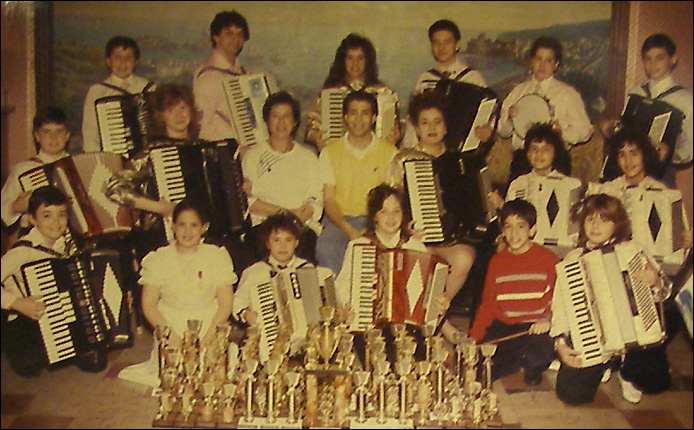 |
|||||||||
|
I have another Greg Naddick, who has a big studio down in south Jersey. He was with the army band and everything. Terri Conti represented the USA in the
International competitions, and in fact, won the 2nd prize in the CIA
International Junior Tape Recording Competition. Later after she joined
the Church of God, she entered a world competition that they have which
included all instruments. The competition was held in Passadena, CA,
and since she always traveled with her accordion, she signed up to be
part of it, and she won 2nd prize against all the other instrumentalists.
In fact, Sylvia Prior was there and was flabbergasted at how well she
did. |
|||||||||
|
|||||||||
|
The walls of Maddalena's
studio are lined with press clippings, pictures, trophies,
accordion figurines, paintings and momentos of many years of world travel. |
|||||||||
|
|||||||||
|
|||||||||
| Have you made any recordings and if so, when did you record your first LP, CD or cassette? | |||||||||
| Pagani made and sold a set of
78 RPM recordings Valse Diane, Rita Polka, and a bellow shake piece. I
did another series of recordings that I don't have a copy of, as they
were sent to South America. I know that they were played over there, but
I don't have a copy. I have copies of the other ones that Pagani made. |
|||||||||
| You have done so many performances, but do you have any memorable highlights that you would like to share with us? | |||||||||
|
|||||||||
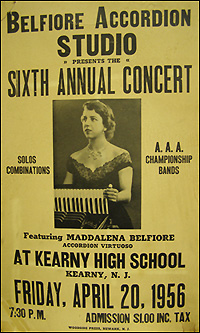 I
did a Première performance with the New Jersey Symphony Orchestra
under the direction of Henry Lewis in Philadelphia. I have the recording
of that. I
did a Première performance with the New Jersey Symphony Orchestra
under the direction of Henry Lewis in Philadelphia. I have the recording
of that.
In 1939 we played at the Worlds Fair in New York with the Nunzio Accordion Orchestra. We used to play in parades and on floats such as on the Columbus Day parade in New York City. That was a big one! I also performed in Castelfidardo, Italy. There was a concert being presented, and Rinaldo Taboldi was on it. The Crucinelli's had mentioned that I was going to be in Italy, so I was invited to play on the concert, and I got a standing ovation for my performance of La Traviata . I played PanCordion, which was built by Crucinelli family. Most of the programs I played were of the
Frosini Overtures and the Novelties. The Novelties were great, as they
served as an exercise. They took the place of doing a lot of exercise
practice. |
|||||||||
| You have had the joy of experiencing an exciting era of accordion in the USA. Are there any accordion stars that you got to know during your accordion career that you would like to mention. | |||||||||
| Of course, there was Frosini.
There was also John Owens. I did a lot of traveling around the United
States doing concerts, and also a lot of studio work. At that time the
studios were all featuring the big name artists, so I got to meet all
of them, including Magnante and others. I also knew many of them through
the American Accordionists Association (AAA).
Not all of the meetings with famous personalities have been so great however. When I was pregnant with my son, I had big concert and at the same time, Mogens Ellegaard from Denmark was going to around doing concerts. In the end, I couldn't do my concert because of my condition and since Mogens was here, I asked him to be a guest artist in my place. After the show we invited him to come to
the house and I didn't think anything of it. We ordered some Pizza and
that was it. It was the American way, a completely 'off the cuff' type
of thing. Then, a few years later I was in Denmark and I met Mogens
again, He came up to me and said "this is the lady that made me
to eat in her kitchen". I'll never forget that! I said to him "well,
when we invite someone, that is how we do it, and at the time with my
condition, I couldn't do more. |
|||||||||
| How many performances do you estimate to have made during your career? | |||||||||
| Just thousands… these included
several a month, solo, concert. |
|||||||||
|
In addition to your outstanding performance, composing and teaching skills, you have also been quite active in several other areas including the organizations. Can you tell us a little bit about your involvement with the the AAA and when this began.
|
|||||||||
 The
AAA has been a very important part of my life. I was a student member
in the early 1950's because Charlie Nunzio was a founding member. Frosini
was very involved as well, so that put me right in there too! If they
weren't I wouldn't have known about it. The
AAA has been a very important part of my life. I was a student member
in the early 1950's because Charlie Nunzio was a founding member. Frosini
was very involved as well, so that put me right in there too! If they
weren't I wouldn't have known about it.
I was elected to the AAA Board of Governors
in 1955. The ones who came in with me, were Marcelo Rivoero and Carmen
Carozza. Tony Etorre was a little later. During the 60's I was elected
Secretary and to other positions of office, and then in 1970 I was elected
President. I was re-elected president twice since then.
During my Presidency, I managed to do govern
over several of the contests, including the one in Nashville, where
we had an orchestra of 1,000 accordionists play. Then we had another
big contest in Hershey PA, and one in Boston in 1984. (Maddalena
is pictured above at the AAA sponsored concert of renowned Russian artist
and teacher Friedrich Lips from Moscow. Left to right: AAA Board members
Faithe Deffner, Kevin Friedrich, guest Friedrich Lips, Maddalena Belfiore,
Carmelo Pino, Linda Soley Reed and Mary Tokarski.) |
|||||||||
| During your career, you have also been extremely active on the International scene. You are by far the longest serving Confédération Internationale des Accordéonistes (CIA) officer from the United States which included 16 years as a Vice President. When did you first attend a CIA event. | |||||||||
 |
|||||||||
|
The first one was in 1957 in Saarbrucken,
Germany, and in fact, I wound up judging it. I don't think they were
too happy! At that time, they didn't want a women judging.
|
|||||||||
| This was an interesting and exciting time for the CIA. At a time before e-mail, you spent much time corresponding with international dignitaries from around the world, conducting the business of the CIA. Do you have any memories from this time that you would like to share? | |||||||||
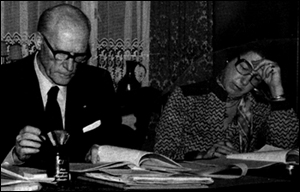 I
always think an interesting one was Lech Puchnowski. He was always very
important in the CIA. We would often lock horns, but we were not enemies.
We both had one goal and that was to improve the competition of the CIA.
Another interesting fascinating personality from that time was Yuri Kolobokov.
He was extremely interesting too. He was always with his little camera,
and he was quite the player. He was during the early 70's, at the time
when there were always the KGB around. I
always think an interesting one was Lech Puchnowski. He was always very
important in the CIA. We would often lock horns, but we were not enemies.
We both had one goal and that was to improve the competition of the CIA.
Another interesting fascinating personality from that time was Yuri Kolobokov.
He was extremely interesting too. He was always with his little camera,
and he was quite the player. He was during the early 70's, at the time
when there were always the KGB around. (Here CIA Vice President Maddalena Belfiore is pictured with CIA President Dr. Karl Albrecht Majer in October, 1977 during the General Assembly meeting in Eindhoven, Netherlands.) We worked hard to try and bring things to a head at our meetings. Everyone was quite strong, and so we either tried to bring things to a vote or matters would be shelved. At that time, they were not used to a women being so strong. We would go to both the winter and summer
CIA congresses. There was so much correspondence and it required so
much diplomacy. |
|||||||||
| What are your views on an organization such as the Confédération Internationale des Accordéonistes (CIA) and the importance it plays in the international music scene. | |||||||||
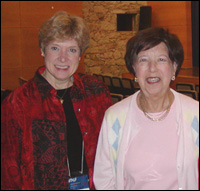 I
think it is very important to have an organization such as the CIA. They
set the criteria and goals for the competitions. As an organization I
think the CIA is doing very fine work. I think they have a very dedicated
president! I think the CIA has come a very long way. I
think it is very important to have an organization such as the CIA. They
set the criteria and goals for the competitions. As an organization I
think the CIA is doing very fine work. I think they have a very dedicated
president! I think the CIA has come a very long way.
I believe that the various CIA member countries
should continue their work commissioning new works for the accordion,
as it enables us to see what is happening with the accordion in the
various parts of the world. This will continually expand our accordion
library. Maybe even a prize could be offered as an incentive for more
works. (Maddalena is pictured in Castelo Branco, Portugal
at the 58th Coupe Mondiale in October 2005, with composer of the 2007
Coupe Mondiale Test Piece Dr. Karen Fremar). |
|||||||||
| You have seen the CIA Coupe Mondiale develop over many years. What are you views on the current competitions?. | |||||||||
 Sometimes
I'm not always in agreement with the selection of the (Coupe Mondiale)
Test Pieces. I would like to see them choose a more melodic type of test
piece rather than the very avante garde pieces that they have sometimes.
On the home front, I think it's very hard for our American students to
cope with some of these new works. Sometimes
I'm not always in agreement with the selection of the (Coupe Mondiale)
Test Pieces. I would like to see them choose a more melodic type of test
piece rather than the very avante garde pieces that they have sometimes.
On the home front, I think it's very hard for our American students to
cope with some of these new works.
If there is one thing I would comment on,
it would be the program content. I would like to see more variety in
the programs in all sections. With the entertainment category, I really
like this a lot, but the problem is that the word 'entertainment' varies
so much across the various countries. What is entertainment in the US
isn't necessarily the same in Europe. This is something that we are
trying to address by offering suggestions as to the possible styles
of music.
We are looking forward to the Coupe Mondiale
in Washington, DC in 2007. We will work together and get it going. |
|||||||||
| As a result of your long time association with the Confédération Internationale des Accordéonistes (CIA) and the contacts you made, you had personally collected documents pertaining to the history of the organization ranging from 1953 to today. Your generous donation of this collection to the CIA enabled them to get the CIA Archive project off the ground. How important is it to preserve these documents and the history of the organization? | |||||||||
 I
think its very important, after all what is history? It is documents!
Without them, it's just a bunch of hearsay. Here we are fortunate enough
to be able to look up things and see when and where they were said, and
so I think it's very important. I
think its very important, after all what is history? It is documents!
Without them, it's just a bunch of hearsay. Here we are fortunate enough
to be able to look up things and see when and where they were said, and
so I think it's very important.
Today with modern communication methods
such as e-mail and instant messenger, I think someone has to be appointed
to make hard copies of all those documents. I've thought of this many
times, not only with the CIA, but also the AAA and ATG, as we are losing
many many documents. We push 'delete' and that is the end of it. Most
of the correspondence would be with the officers of the organizations,
so they should be obtainable and therefore should be printed and preserved
for historical purposes as a Word document for example. |
|||||||||
| What non accordion music do you most like to listen to? | |||||||||
|
I really love Latin music and the Symphony.
If I really answer you, as to what music I enjoy the most, it is the
music that I am playing at the time. I enjoy it all. If it's good, it
is good! |
|||||||||
| What other interests and hobbies besides music do you have? | |||||||||
|
I used to play golf.. and I love needlepoint..
you can see I have some hanging on the wall. I also love boating. |
|||||||||
| What do you regard as your greatest achievement? | |||||||||
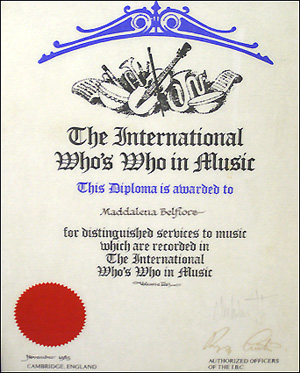 I
am most proud of the work done with the national competitions, where I
was able to benefit a tremendous amount of people. With one competition,
I flew down to Nashville with Lana Gore. We met with her uncle who worked
with one of the TV stations, and had invited us down there. The three
of us looked everything over, and we coordinated the entire thing and
made the contest together. That was a joint effort. I
am most proud of the work done with the national competitions, where I
was able to benefit a tremendous amount of people. With one competition,
I flew down to Nashville with Lana Gore. We met with her uncle who worked
with one of the TV stations, and had invited us down there. The three
of us looked everything over, and we coordinated the entire thing and
made the contest together. That was a joint effort. 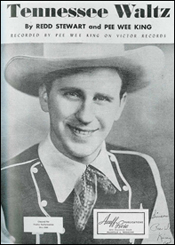 We
also had a Public Relations guy, who was very very good and came into
it as well. He managed to coordinate the big publicity and the event where
I conducted 1,000 accordionists playing the Tennessee State Song the "Tennessee
Waltz" from a Cherry Picker. We
also had a Public Relations guy, who was very very good and came into
it as well. He managed to coordinate the big publicity and the event where
I conducted 1,000 accordionists playing the Tennessee State Song the "Tennessee
Waltz" from a Cherry Picker. It was in 1980, because I remember when I was in Australia later that year after the Coupe Mondiale in Auckland, New Zealand and Elsie Brandman from the Australian Society of Accordionists said that she had seen me on television in Australia, conducting this massive Festival Orchestra in Nashville. It had been broadcast around the world by the ABC News affiliate. 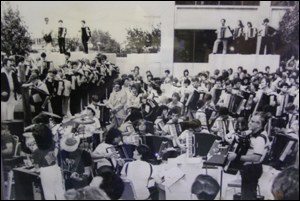 The
"Tennessee Waltz" was written by Redd Stewart with Pee Wee King
in 1948. (King & Stewart decided to write the song after hearing Bill
Monroe's Kentucky Waltz on the radio. Stewart emptied a matchbox and tore
it open to write down the song.) In 1951 Patti Page took "The Tennessee
Waltz" to No.1 on the Pop chart, which also became a Top 3 Country
hit. It went on to sell over 6 million copies. In 1965 the "Tennessee
Waltz" was officially proclaimed by Governor Frank Clement as the
Tennessee Sate Song. The
"Tennessee Waltz" was written by Redd Stewart with Pee Wee King
in 1948. (King & Stewart decided to write the song after hearing Bill
Monroe's Kentucky Waltz on the radio. Stewart emptied a matchbox and tore
it open to write down the song.) In 1951 Patti Page took "The Tennessee
Waltz" to No.1 on the Pop chart, which also became a Top 3 Country
hit. It went on to sell over 6 million copies. In 1965 the "Tennessee
Waltz" was officially proclaimed by Governor Frank Clement as the
Tennessee Sate Song.Both Redd Stewart (May 27, 1923 - August 2, 2003) and Pee Wee King (February 18, 1914 - March 7, 2000) attended the unique AAA Mass Accordion Orchestra performance of their No. 1 Hit, conducted by Maddalena Belfiore. |
|||||||||
| What are your thoughts regarding competitions? | |||||||||
|
Competitions are good, as they give students
the incentive to practice. It shouldn't be about putting all the emphasis
on winning or losing, but by going into a competition they learn music!
They have to learn their one, two or three pieces. It provides a helpful
purpose to the lessons… to play their music and to play it well. |
|||||||||
| What musical advice do you have for aspiring accordionists? | |||||||||
| Listen to your teacher, and
very important - practice! You have to have goals. Also, what happens
today (different from when I studied) is that no one has a chance to play
any place. I used to play at all these Clubs and Organizations, and that
doesn't happen so much any more I feel. I don't get calls at the studio
like I used to asking for performers. It does happen of course, but not
like it used to. Now if they get anyone, they get a group of entertainers..
rather than a student soloist. Maybe the teachers could help do more to promote it. We used to play any place we could. It was all part of the teaching and learning process. Kids going out to play publicly is probably the best lesson they could ever learn! Students learn from competitions also,
but to have a 'goal' of learning to play something and playing
it well, that's what is important... to have that goal! |
|||||||||
|
|||||||||
|
|
|||||||||
 Maddalena
Belfiore at a glance:
Maddalena
Belfiore at a glance: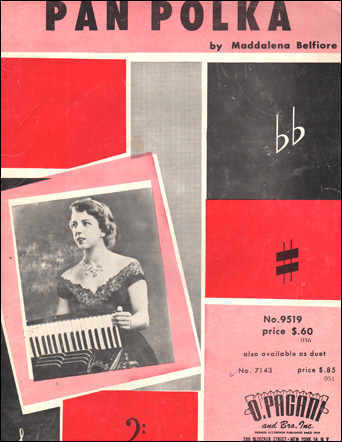
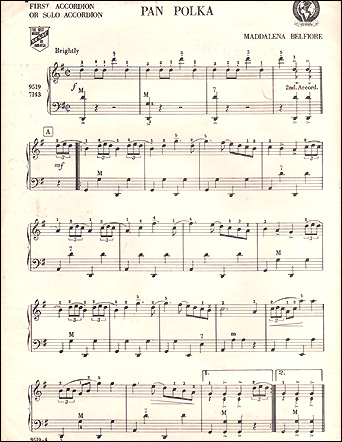
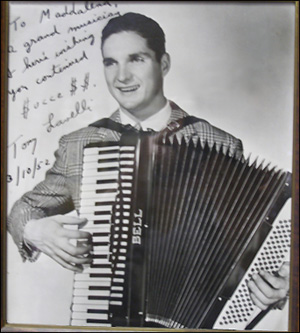

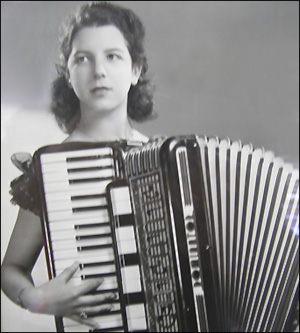
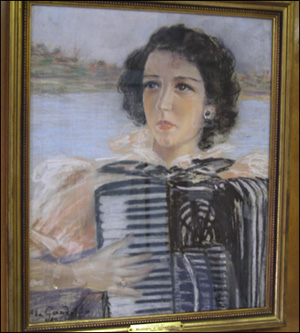


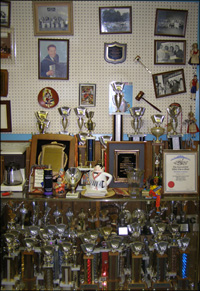
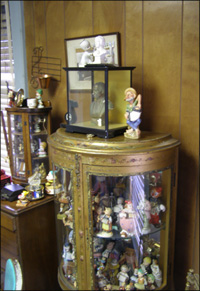
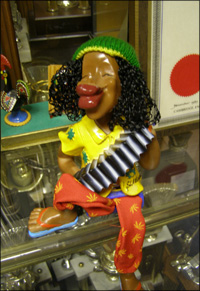



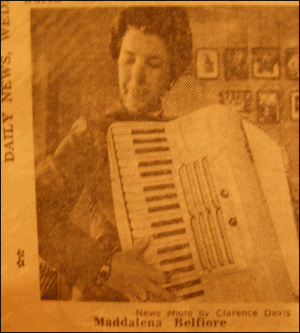
 The
CIA Coupe Mondiale the way it is today is quite ambitious having so
many categories and various requirements. However, as far as the program
goes, its pretty common today with the Tchaikowsky and other big International
competitions, as they all require pretty lengthy programs as well, so
we are on a par in that respect.
The
CIA Coupe Mondiale the way it is today is quite ambitious having so
many categories and various requirements. However, as far as the program
goes, its pretty common today with the Tchaikowsky and other big International
competitions, as they all require pretty lengthy programs as well, so
we are on a par in that respect.